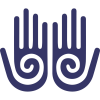A lot of my massage clients nowadays are people who work from home. And as you might easily guess, the main issue they want to address is back pain. And yes, massage can help alleviate it. It makes more space in the body, releases tension, softens muscles and reduces overall stress. But if you go out of my therapy room and continue doing what you usually do, then most probably and before too long you will be in need of another treatment.
Regular massage is great to reboot the system and can keep your body in a good shape. But it simply cannot fully counteract the physical demands of sitting and inactivity for hours on end, day after day.
What does the data say
This isn’t just an observation from my massage practice. The data is starting to paint a similar, concerning picture on a national scale. A study from 2022 showed the number of people identified as economically inactive because of long-term sickness in the UK had increased from 2 million to 2.5 million in the three years from 2019. More than 70% of the rise occurred after the arrival of Covid in early 2020. A breakdown of the total showed that the number leaving the labour force because of neck and back problems rose by 62,000 – the second-largest reason cited.
While older individuals still form the largest group affected by long-term sickness, the sharpest relative increase has been seen in younger adults. This suggests that our modern work habits are taking a toll across the age spectrum.
The link seems clear: spending hours hunched over laptops on kitchen tables, sofas, or beds in awkward postures contributes to overuse injuries and back pain.
A proactive approach
So how can we avoid this? We can’t stop working, right? Well, we can become stronger and better prepared for prolonged sitting. Because, maybe counterintuitively, sitting even in the best ergonomic chair is hard on the body.
Practices integrated into your daily or weekly routine, like yoga, provide the ongoing building blocks for a stronger, more resilient back. Yoga is a powerful tool that directly addresses many of the root causes of back pain stemming from inactivity and poor posture.
How does yoga help
I am teaching a weekly yoga class in Streatham. If you are interested in addressing your back pain with yoga and want to explore how the practice can help you, you are most welcome to join me.
You don’t need to be flexible or experienced to start. There are plenty of simple yoga poses for back pain relief that are accessible to beginners.
Here is what you will learn in my classes:
- Improve spine mobility: Find places in your spine that feel stuck and use micro movements and axial extension to improve mobility and to make space between the vertebrae.
- Strengthen back muscles: Strengthen the muscles of the back to stand taller and feel lighter.
- Activate and engage your core: Create a strong and stable core, essential for proper posture and supporting your entire body.
- Address tightness in the hips and improve pelvic alignment: Address hamstring and hip flexor tightness. Release tension in the hips and pelvis, leading to better alignment of the torso and the spine.
- Open the chest and realign the head: Work on the alignment of the shoulders and the neck to support the natural curves of the spine.
- Modifications and variations to choose your right level of challenge.
By incorporating yoga into your routine, you’re not just treating the symptom; you’re actively building strength, improving flexibility, and cultivating body awareness to counteract the effects of desk life.
Want to know more about the classes? Click here.
Related articles:
The Joyful Hippo: Staying Playful (and Functional!) as We Age
Yoga for Active Ageing: 5 Reasons to Start Today



